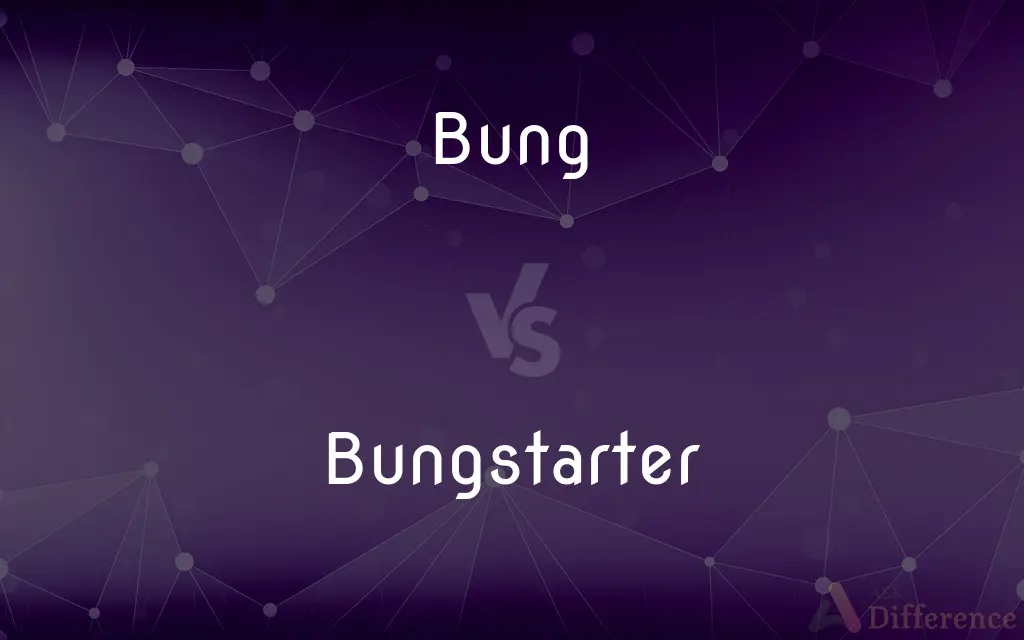Bung vs. Bungstarter — What's the Difference?
Edited by Tayyaba Rehman — By Fiza Rafique — Updated on April 24, 2024
"Bung" typically refers to a stopper for sealing a container, especially barrels, while "bungstarter" is a specific tool used to open or insert a bung in barrels.

Difference Between Bung and Bungstarter
Table of Contents
ADVERTISEMENT
Key Differences
A "bung" is primarily used as a sealant for barrels or other containers that hold liquids, particularly alcoholic beverages like wine or beer. In contrast, a "bungstarter" is a tool designed specifically to help insert or remove these bungs without damaging them or the barrel.
The bung itself is usually made from materials such as wood, rubber, or silicone, tailored to ensure a tight fit and prevent leaks. The bungstarter, on the other hand, might be crafted from wood or metal, designed to leverage against the bung efficiently and safely.
Using a bung involves placing it into the hole of a barrel to seal it, which helps in processes such as fermentation where an airtight seal is crucial. The bungstarter, however, is employed to either pry open a tightly fitted bung or to tap it securely into place.
Bungs are essential components in industries like winemaking or brewing, where maintaining the quality of the contents over time is vital. Whereas bungstarters are necessary tools in these industries, facilitating the frequent opening and sealing of barrels during the production process.
While a bung is a passive component that serves as a part of the containment system, a bungstarter is an active tool used to manipulate the bung, reflecting the dynamic versus static roles they play in container management.
ADVERTISEMENT
Comparison Chart
Definition
A stopper used to seal a container, particularly a barrel.
A tool used to insert or remove a bung from a barrel.
Material
Made from wood, rubber, or silicone.
Typically made from wood or metal.
Function
Seals containers to prevent leaks and facilitate processes like fermentation.
Helps in inserting and removing bungs without damaging them or the barrel.
Use Case
Essential in industries like winemaking or brewing.
Necessary tool for managing barrel openings in similar industries.
Role
Passive component in containment systems.
Active tool used in the management of containment systems.
Compare with Definitions
Bung
A stopper for sealing barrels, especially in liquid storage.
He placed the bung in the wine barrel to start the aging process.
Bungstarter
Helps in maintaining an efficient production process in breweries.
Every brewmaster keeps a bungstarter handy for quick access to barrel contents.
Bung
Used in chemical and food industries for sealing containers.
The bung was inspected for any signs of wear or leakage.
Bungstarter
Designed to manipulate bungs without causing damage.
The bungstarter made it easy to replace the bung during routine sampling.
Bung
Rubber or wooden seal used in fermentation vessels.
The brewer checked the bung to ensure it was air-tight.
Bungstarter
Used frequently in winemaking to manage barrel openings.
The new bungstarter was more effective at not damaging the wood.
Bung
Integral to preserving the integrity of container contents.
Replacing a worn-out bung is important to prevent contamination.
Bungstarter
Ensures the proper functioning of bungs in industrial settings.
Regular use of the bungstarter helps in keeping the barrel seal intact.
Bung
Device used to maintain the quality of stored substances.
A proper bung is crucial for the long-term storage of craft beers.
Bungstarter
A tool for opening or sealing barrels with bungs.
He used the bungstarter to open the old ale barrel.
Bung
A stopper, especially for the hole through which a cask, keg, or barrel is filled or emptied.
Bungstarter
A tool for opening barrels by removing the bung.
Bung
A bunghole.
Bung
To close with a cork or stopper.
Bung
(Informal) To injure or damage
Fell on skis and bunged up my leg.
Bung
Chiefly British To fling; toss.
Bung
A stopper, alternative to a cork, often made of rubber, used to prevent fluid passing through the neck of a bottle, vat, a hole in a vessel etc.
Bung
The cecum or anus, especially of a slaughter animal.
Bung
(slang) A bribe.
Bung
The orifice in the bilge of a cask through which it is filled; bunghole.
Bung
A sharper or pickpocket.
Bung
The landlord of a public house.
Bung
A purse.
Bung
(transitive) To plug, as with a bung.
Bung
To put or throw something without care; to chuck.
Bung
(transitive) To batter, bruise; to cause to bulge or swell.
Bung
(transitive) To pass a bribe to (someone).
Bung
Broken, not in working order.
Bung
The large stopper of the orifice in the bilge of a cask.
Bung
The orifice in the bilge of a cask through which it is filled; bunghole.
Bung
A sharper or pickpocket.
You filthy bung, away.
Bung
To stop, as the orifice in the bilge of a cask, with a bung; to close; - with up.
He had bunged up his mouth that he should not have spoken these three years.
Bung
A plug used to close a hole in a barrel or flask
Bung
Give a tip or gratuity to in return for a service, beyond the agreed-on compensation;
Remember to tip the waiter
Fee the steward
Bung
Close with a cork or stopper
Common Curiosities
Can a bungstarter be used on any type of bung?
Bungstarters are generally designed to be compatible with most standard bungs used in barrels but checking compatibility is advisable.
What materials are bungs made from?
Bungs are commonly made from materials like rubber, wood, or silicone, depending on the required seal quality and durability.
What is a bung used for?
A bung is used to seal barrels and other containers, especially in the brewing and winemaking industries.
How does a bungstarter work?
A bungstarter is used to pry open or tap in a bung into a barrel, facilitating easy access without damaging the barrel or bung.
Why is it important to use a bungstarter instead of other tools?
Using a bungstarter helps avoid damage to both the bung and the barrel, which can prevent leaks and preserve the quality of the barrel's contents.
What are the safety considerations when using a bungstarter?
Safety considerations include ensuring the tool is used properly to avoid personal injury and to prevent damage to the barrel and bung.
How often should bungs be replaced?
Bungs should be replaced whenever they show signs of wear or fail to provide an airtight seal.
Are bungs and bungstarters used in other industries besides brewing?
Yes, they are also used in various food processing, chemical industries, and wherever liquid storage in barrels is common.
Is there a specific way to maintain bungs and bungstarters?
Regular cleaning and inspection for wear or damage are essential to maintain the effectiveness of bungs and bungstarters.
Are there different types of bungstarters for different barrel sizes?
Yes, bungstarters may come in different sizes or designs to accommodate different barrel openings and bung sizes.
How can improper use of a bung affect wine or beer quality?
Improper sealing with a bung can lead to oxidation or contamination, adversely affecting the flavor, aroma, and safety of the wine or beer.
How do you choose the right bung for a barrel?
The right bung should fit snugly, be made of a material suitable for the stored substance, and be compatible with the barrel’s material.
What happens if a bung fails?
If a bung fails, it can lead to leaks, exposure to air, and potential spoilage or contamination of the barrel’s contents.
Can bungs be reused?
Bungs can sometimes be reused if they are still in good condition and clean, but frequent replacement is recommended for optimal sealing.
What are common problems encountered with bungs and how are they addressed?
Common problems include leaks, improper fits, and deterioration of material, typically addressed by replacing the bung or using a better-suited material.
Share Your Discovery

Previous Comparison
Ladybird vs. Ladybug
Next Comparison
Shackles vs. HandcuffsAuthor Spotlight
Written by
Fiza RafiqueFiza Rafique is a skilled content writer at AskDifference.com, where she meticulously refines and enhances written pieces. Drawing from her vast editorial expertise, Fiza ensures clarity, accuracy, and precision in every article. Passionate about language, she continually seeks to elevate the quality of content for readers worldwide.
Edited by
Tayyaba RehmanTayyaba Rehman is a distinguished writer, currently serving as a primary contributor to askdifference.com. As a researcher in semantics and etymology, Tayyaba's passion for the complexity of languages and their distinctions has found a perfect home on the platform. Tayyaba delves into the intricacies of language, distinguishing between commonly confused words and phrases, thereby providing clarity for readers worldwide.
















































